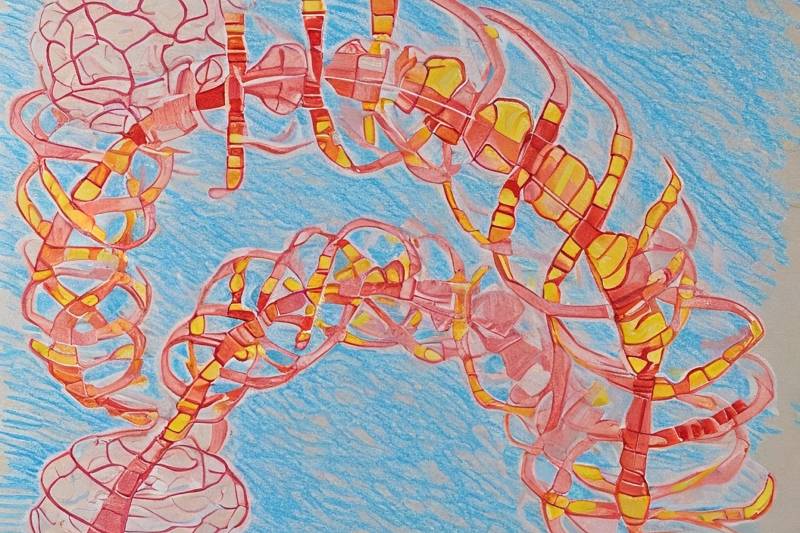A previously unidentified genetic mutation in a small protein provides significant protection against Parkinson’s disease and offers a new direction for exploring potential treatments, according to a new USC Leonard Davis School of Gerontology study.
The variant, located in a mitochondrial microprotein dubbed SHLP2, was found to be highly protective against Parkinson’s disease; individuals with this mutation are half as likely to develop the disease as those who do not carry it. The variant form of the protein is relatively rare and is found primarily in people of European descent.
The findings appear on January 3, 2024, in the journal Molecular Psychiatry.
First discovered by Pinchas Cohen at the USC Leonard Davis School in 2016, SHLP2 is made within the cell’s mitochondria. Previous research from the Cohen Lab established that SHLP2 is associated with protection from aging-related diseases including cancer and that levels of the microprotein change in patients with Parkinson’s disease; they rise as the body attempts to counteract the pathology of Parkinson’s disease but often fail to mount additional production as the disease progresses.
This latest finding builds upon the USC team’s prior mitochondrial research and represents an advance at the intersection of longevity science, precision health, and microprotein discovery.
“This study advances our understanding of why people might get Parkinson’s and how we might develop new therapies for this devastating disease,” said Cohen, professor of gerontology, medicine and biological sciences and senior author of the study. “Also, because most research is done on well-established protein-coding genes in the nucleus, it underscores the relevance of exploring mitochondrial-derived microproteins as a new approach to the prevention and treatment of diseases of aging.”
For this study, first author Su-Jeong Kim, an adjunct research assistant professor of gerontology at the USC Leonard Davis School, led a series of experiments that leveraged the Lab-developed microprotein discovery pipeline that begins with a big data-driven analysis to identify variants involved in disease. Thousands of human study subjects from the Health & Retirement Study, Cardiovascular Health Study, and Framingham Heart Study were screened for the SHLP2 variant. By comparing genetic variants in the mitochondrial DNA in patients with Parkinson’s disease and in controls, researchers found a highly protective variant found in 1% of Europeans, that reduced risk of Parkinson’s disease by twofold, to 50% of average.
Next, they demonstrated that this naturally occurring variant results in a change to the amino acid sequence and protein structure of SHLP2. The mutation – a single nucleotide polymorphism (SNP), or a change to a single letter of the protein’s genetic code – is essentially a “gain-of-function” variant that is associated with higher expression of SHLP2 and also makes the microprotein more stable. According to their findings, the SHLP2 variant has high stability compared to the more common type and provides enhanced protection against mitochondrial dysfunction.
The research team was able to use targeted mass spectrometry techniques to identify the tiny peptide’s presence in neurons and found that SHLP2 specifically binds to an enzyme in mitochondria called mitochondrial complex 1. This enzyme is essential for life, and declines in its function have been linked not only to Parkinson’s disease but also to strokes and heart attacks.
The increased stability of the SHLP2 variant means that the microprotein binds to mitochondrial complex 1 more stably, prevents the decline of the enzyme’s activity, and thus reduces mitochondrial dysfunction. The benefits of the mutant form of SHLP2 were observed in both in vitro experiments in human tissue samples as well as in mouse models of Parkinson’s disease, according to the study.
“Our data highlights the biological effects of a particular gene variant and the potential molecular mechanisms by which this mutation may reduce the risk for Parkinson’s disease,” said Kim. “These findings may guide the development of therapies and provide a roadmap for understanding other mutations found in mitochondrial microproteins.”
Coauthors included Brendan Miller, Nicolas G. Hartel, Ricardo Ramirez II, Regina Gonzalez Braniff, Naphada Leelaprachakul, Amy Huang, Yuzhu Wang, Thalida Em Arpawong, Eileen M. Crimmins, Kelvin Yen, Giselle M. Petzinger, Michael W. Jakowec, and Nicholas A. Graham of USC; Penglong Wang and Chunyu Liu of the National Heart, Lung, and Blood Institute, National Institutes of Health; and Xianbang Sun and Daniel Levy of Boston University.
This work was supported by Department of Defense grant W81XWH2110625 to Kim and by NIH grants P01AG034906, R01AG068405 and P30AG068345 to Cohen. Pinchas Cohen is a consultant of CohBar Inc.


